|
West Street
Harrietsham
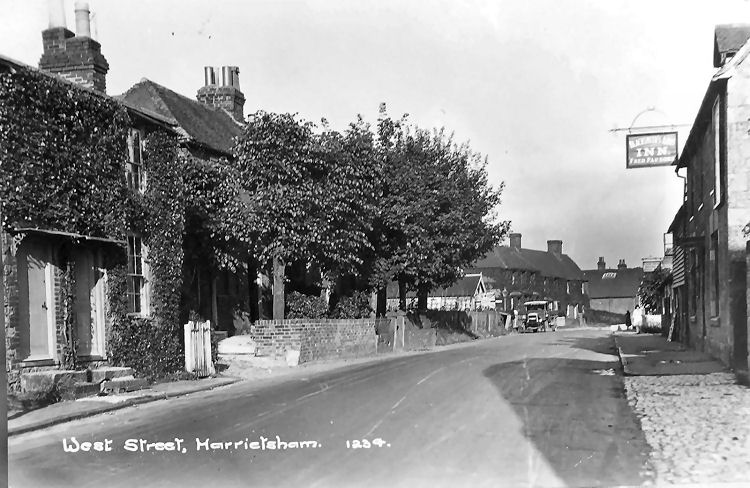
Above postcard 1918, kindly sent by Rory Kehoe. |
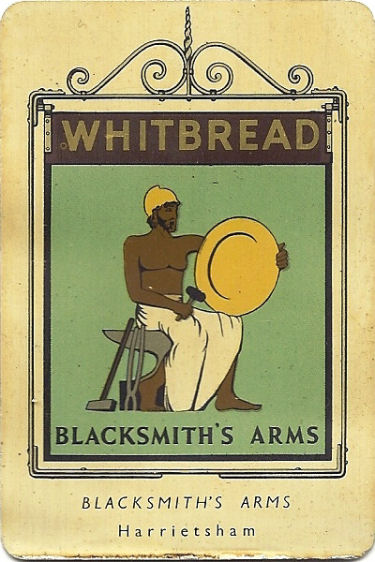 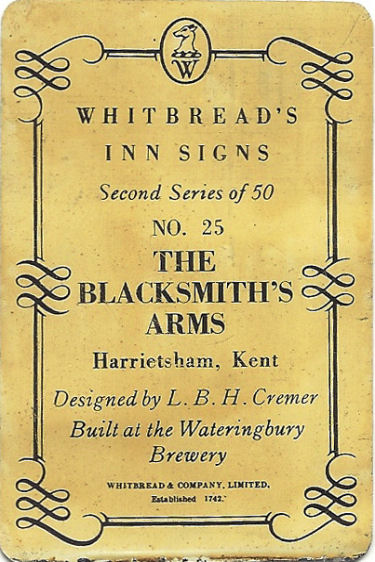
Above aluminium card issued 1950. Sign series 2 number 25. |
|
Southeastern Gazette, 12 April 1853.
WEST KENT QUARTER SESSIONS.
These Sessions commenced on Tuesday last, before the Earl of Romney,
chairman, and a bench of magistrates,
A second court, in which J.’Espinasse, Esq., presided, was opened on
Tuesday morning. The following prisoners were tried:—
Richard Clements Tyler, 62, wheelwright, for stealing a pair of
shoes, value 10s., the property of James Tong, at Harrietsham.
The prisoner was at the house of the prosecutor, a brick-layer and
beer-house keeper at Harrietsham, on the evening of the 10th
November, and slept there that night. After he had gone to bed,
prosecutor passed the door of the bed-room in which he was sleeping,
and which, was open, when he observed the boots, with some others
belonging to his children, in the window. In the morning the
prisoner got up early and went away, and prosecutor missed the
boots. Mr. Ambrose, of Harrietsham, while on his way with his horse
and cart that morning to Liverton-street, overtook the prisoner with
a bundle, and having heard of something having been stolen by him,
he asked him if he liked to ride, and when they got to Liverton,
gave him into custody. His bundle was searched, and the shoes were
not found in it, but they were that morning picked up in the track
of the cart. Prisoner had sat on the nearside, and one of the boots
were picked up where the near wheel had passed.
Six weeks’ hard labour.
|
|
From the Harrietsham Times, July 1916.
Fred Parsons, aged 36, licensee of the "Blacksmith's Arms" and coal merchant and
contractor, he was awarded two months exemption.
|
|
From an email received 24 March 2018.
Blacksmith’s Arms Harrietsham.
Built 1779 – dated beam in entrance hall – was used as Poor House
until 1840 when it was sold to James Tong the village bricklayer.
In
about 1820 it was reported that the village schoolmaster had been lodged
for some time in the Parish Poor House. Evidently in the
first part of the nineteenth century, the Poor of Harrietsham had been
exported to the
neighbouring parish of Hollingbourne. The Poor House then had doubled as
schoolroom
and schoolmaster’s house. However, by 1820 the cross-parish arrangement
had ended and
the Poor of Harrietsham needed housing once again. There was no room for
either pupils
or Master!
James Tong was not a good business man, but he did try! He turned the
“house” into a beer shop. He raised mortgage upon mortgage on the
property for several decades – mainly with a solicitor from Wateringbury
who had some connection with the brewery there. In the end the “house”
mortgage was foreclosed and “beer shop” became a pub [Leney’s brewery
I think.] Then Fremlins took it on and finally Whitbread Brewery tried to
make a go of it.
When it was sold into private hands [Paul and Diana Passey 1976] it was
because the village of Harrietsham had the "Roebuck," the "Bank House," the
"Bell," the "Blacksmith’s Arms" and a Working Men’s Club – even Harrietsham
could not drink sufficient beer!

I attach sequential pictures – publican in early 70’s? Showing Leslie
Hope and her daughter-in-law, Shirley
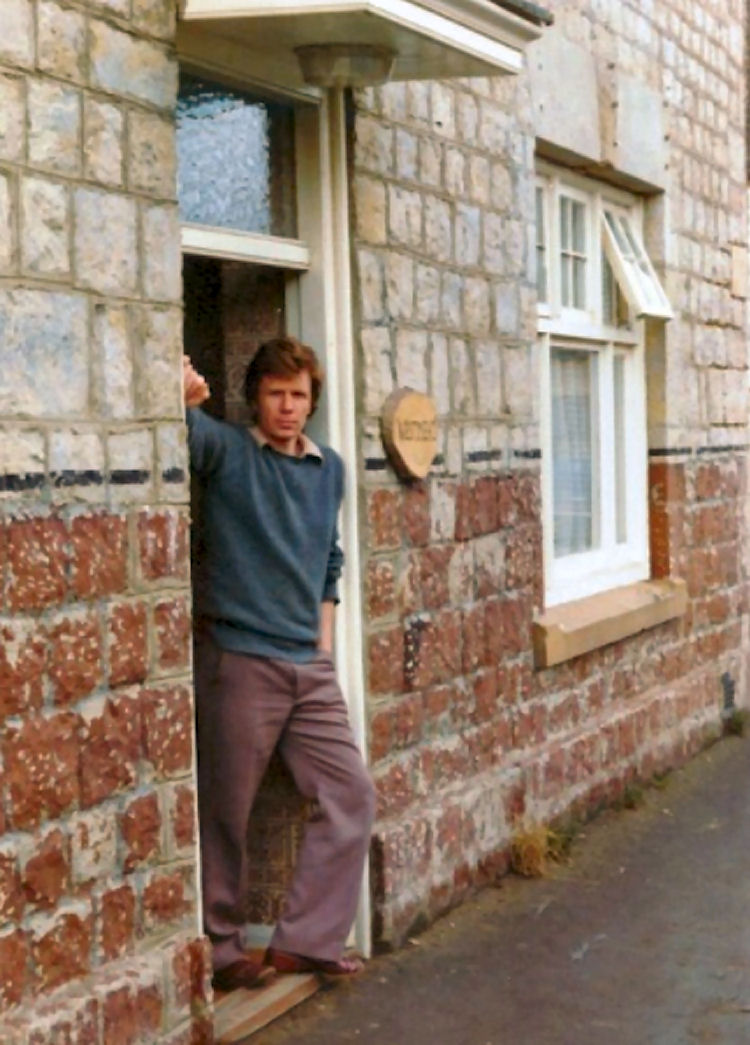
Paul Passey at the pub
door after removal of pebbledash revealed the Fremlins influence [1980?]
kindly sent by Paul Passey.
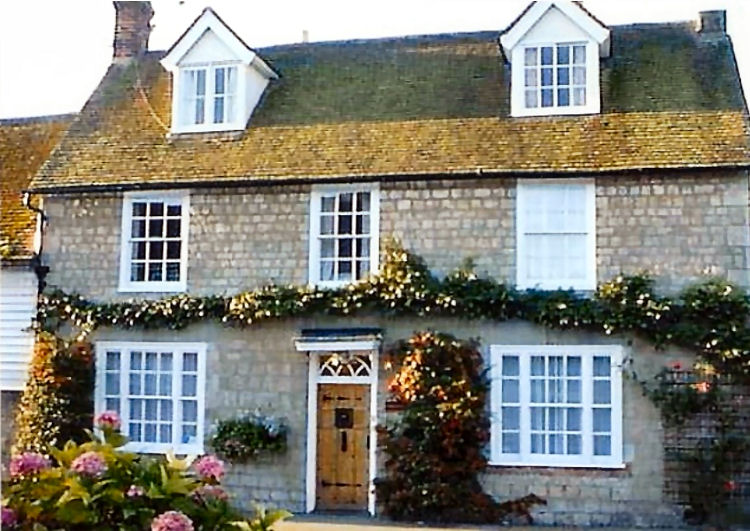
“Westmead as we left it [2002]
Paul Passey.
|
The pub finally closed its doors to the public in February 1975.
I am informed by Dave Fahey whose father Frederick John Fahey, was the
last licensee that the building was not in good repair and Whitbread’s
decided to de-licence it and sell it as a private house. It was run as a
guest house for a while, known as Westmead House, but after a few years
became a private house.
There was a large beam that ran from front to back of the ground floor
which had “1779” carved into it. He also says "When we moved in it still had
the original gas lights upstairs in the living quarters."
At the back, there was a two-storey stable block which still had the old
wooden mangers and cobbled floor. This was demolished by the person who
bought the building from Whitbread’s. I remember the asking price was
£30,000; we all said that “nobody would pay that”; the property was built of
ragstone, which had turned porous, and subsequently it was very damp inside;
a few years ago it was on the market for £385,000! It does seem to have
changed hands frequently since being de-licensed, I would guess that this as
a result of it being haunted. We certainly had many unexplained happenings
there, as did a previous tenant, Les Hope, who was there for 27 years.
According to his son, Michael, Land Girls billeted there during World War 2
wouldn’t sleep in the front room, despite there being three of them.
Behind the stables was a large field which later became “Wheelwrights
Close”. The car park at the side of the pub had been the wheelwright’s shop,
but I’m not 100% sure when that was demolished, I vaguely remember a
customer saying 1970.
Project 2014 has been started to try and identify all the pubs that are
and have ever been open in Kent. I have just added this pub to that list but
your help is definitely needed regarding it's history.
As the information is found or sent to me, including photographs, it will
be shown here.
Thanks for your co-operation.
LICENSEE LIST
TONG James 1840+ (also bricklayer)
PARSONS Fred 1916+
HOPE Leslie after 1939-70ish
FAHEY Frederick John 26/Apr/1972-Feb/75

|





